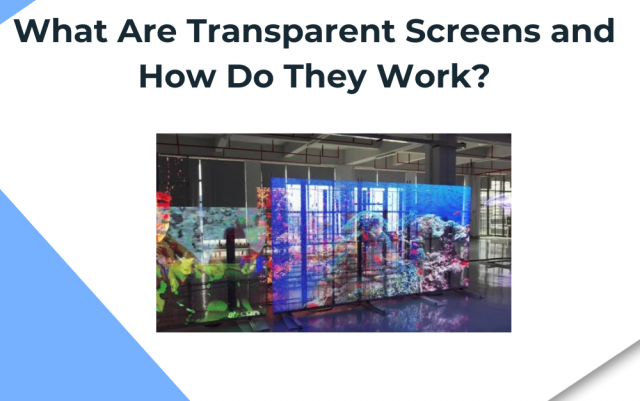Transparent screens have rapidly emerged as one of the most exciting and innovative advancements in modern display technology. These screens combine the best of visual display technology with the ability to maintain transparency, creating a unique and immersive experience for users. As a result, transparent screens are making waves in various industries, including retail, advertising, architecture, and automotive sectors. This article will delve into what transparent screens are, how they work, their applications, and the benefits they offer in different fields.
NOTE: Transparent Screens in Dubai have gained significant popularity, offering a unique visual experience across numerous sectors. Acrylic Market has been at the forefront, providing high-quality transparent screen solutions for businesses looking to innovate their display systems.
What Are Transparent Screens?
Transparent screens, as the name suggests, are display systems that allow light to pass through them while displaying images or content. These displays can be made from various materials, including glass, acrylic, or plastic, and often incorporate advanced technologies such as OLED (Organic Light Emitting Diode) or LCD (Liquid Crystal Display) to produce images. Unlike traditional screens, transparent screens can display content while remaining clear enough to allow objects or scenes behind them to be visible.
The primary feature of transparent screens is that they offer a dual functionality: they serve as a display for digital content while maintaining transparency, allowing them to blend seamlessly into their environment. This makes them a versatile solution for a wide range of applications, from interactive displays in retail environments to futuristic automotive dashboards.
How Do Transparent Screens Work?
Transparent screens use a combination of cutting-edge display technologies to create visually compelling content while maintaining transparency. Below are the primary components involved in their operation:
1. OLED Technology
One of the most commonly used technologies for transparent displays is OLED (Organic Light Emitting Diode). OLEDs are made up of organic materials that emit light when an electric current is applied. This technology enables screens to be thin, flexible, and capable of displaying vibrant colors while maintaining transparency. OLED panels allow more light to pass through compared to traditional LED screens, making them ideal for transparent displays.
2. LCD Technology
Another technology used in transparent screens is LCD (Liquid Crystal Display). LCD screens utilize liquid crystals that can be manipulated to either block or allow light to pass through. While LCD screens can be made transparent, they generally do not offer the same level of transparency and color vibrancy as OLED displays. However, they are still used in certain transparent screen applications.
3. Light Guide Plates and Optical Films
To enhance the visibility and brightness of transparent screens, light guide plates (LGPs) and optical films are often used. These components help direct and diffuse light, improving the overall performance of the display. They play a crucial role in ensuring that the content displayed on the transparent screen is clear and visible, even in brightly lit environments.
4. Smart Glass Technology
Smart glass technology, which is often combined with transparent screens, allows users to control the transparency of the screen. This means that users can adjust the level of transparency depending on the context and desired effect. For example, smart glass screens can go from fully transparent to opaque with just a flick of a switch or a change in the electric current.
Applications of Transparent Screens
The versatility of transparent screens makes them suitable for a wide range of applications across different industries. Below are some of the key areas where transparent screens are being utilized:
1. Retail and Advertising
In the retail industry, transparent screens are revolutionizing the way brands interact with customers. Retailers can use transparent displays in windows to showcase advertisements or product information without obstructing the view of the store interior. These screens can also be used for interactive displays, where customers can engage with the content while still seeing the products or environment behind the screen. Transparent screens in retail enhance customer engagement and make the shopping experience more immersive.
2. Automotive Industry
In the automotive sector, transparent screens are becoming an integral part of the dashboard and infotainment systems. They are used to display navigation information, vehicle data, and entertainment options without cluttering the dashboard. Transparent screens in vehicles create a futuristic, sleek, and clutter-free design while providing drivers with essential information. In some cases, transparent screens can even be integrated into the windshield, acting as augmented reality displays that overlay important driving information directly onto the road view.
3. Architecture and Interior Design
Transparent screens are also gaining traction in architecture and interior design, where they can be used as dynamic partitions, windows, or interactive displays. These screens can transform ordinary glass windows into displays that can showcase artwork, advertisements, or even functional information. Transparent screens provide an innovative solution for modern architectural designs, combining aesthetics with functionality.
4. Public Information and Transportation
Transparent screens have found their place in public information systems, such as in airports, train stations, and bus terminals. These screens are used to display real-time information, such as flight schedules, train arrivals, and emergency announcements, without obstructing the view of the surroundings. In transportation, transparent displays can be integrated into buses, trains, and subway cars, providing passengers with entertainment, travel information, and advertisements without compromising on visibility.
5. Consumer Electronics
Consumer electronics, such as smartphones, tablets, and wearable devices, are also experimenting with transparent screen technology. Transparent screens in smartphones could provide users with additional functionality, such as multitasking or accessing different layers of information while still being able to view the environment around them. Transparent displays could also be incorporated into augmented reality (AR) and virtual reality (VR) devices, enhancing the user experience by providing a more immersive, interactive environment.
Benefits of Transparent Screens
Transparent screens offer numerous benefits that set them apart from traditional displays. Here are some of the key advantages of using transparent screens:
1. Enhanced Visual Appeal
Transparent screens provide a visually stunning and futuristic look that traditional displays cannot match. They create a seamless blend between digital content and the physical environment, making them ideal for creative displays in retail, architecture, and other design-centric industries.
2. Space-Saving and Versatility
One of the significant benefits of transparent screens is that they save space. By combining a display with a transparent surface, these screens eliminate the need for separate display screens, making them ideal for environments where space is limited. They can be used in places where traditional screens would be impractical, such as on windows, walls, or even as part of the structure of a building.
3. Increased Engagement
Transparent screens engage users in a way that traditional screens cannot. The ability to see through the screen while interacting with digital content creates a more immersive experience. Whether in a retail setting or a public transportation environment, transparent displays encourage users to engage more deeply with the content, enhancing brand interaction and customer experience.
4. Energy Efficiency
Transparent screens, particularly those that use OLED technology, are energy-efficient. Unlike traditional screens that require backlighting, OLED displays emit their light, reducing energy consumption. This makes transparent screens a more sustainable option for businesses and organizations looking to minimize their environmental impact.
The Future of Transparent Screens
The future of transparent screens looks promising, with ongoing research and development aimed at improving the technology and expanding its applications. As transparent displays continue to evolve, we can expect them to become even more integrated into our daily lives, from smart homes and digital signage to immersive entertainment experiences and advanced automotive systems.
Conclusion
Transparent screens are an exciting and innovative advancement in display technology, offering a unique blend of functionality and aesthetics. Whether used in retail, automotive, architecture, or consumer electronics, these screens are transforming the way we interact with digital content. As the technology continues to evolve, transparent screens will play an increasingly important role in various industries, enhancing user experiences and creating new possibilities for the future.
For More Insightful Articles Related To This Topic, Feel Free To Visit: livepositively






